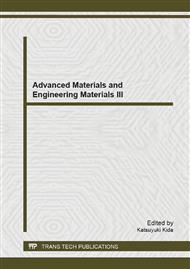[1]
K.S. Novoselov, A.K. Geim, S.V. Morozov, D. Jiang, Y. Zhang, S.V. Dubonos, I.V. Grigorieva, A.A. Firsov, Electric field effect in atomically thin carbon films, Science 306 (2004) 666-669.
DOI: 10.1126/science.1102896
Google Scholar
[2]
Y. Zhu, S. Murali, W. Cai, X. Li, J.W. Suk, J.R. Potts, R.S. Ruoff, Graphene and graphene oxide: synthesis, properties, and applications, Adv. Mater. 22 (2010) 3906-3924.
DOI: 10.1002/adma.201001068
Google Scholar
[3]
R.S. Edwards, K.S. Coleman, Graphene synthesis: relationship to applications, Nanoscale 5 (2013) 38-51.
Google Scholar
[4]
M. Wu, C. Cao, J.Z. Jiang, Light non-metallic atom (B, N, O and F)-doped graphene: a first-principles study, Nanotechnology 21 (2010) 505202.
DOI: 10.1088/0957-4484/21/50/505202
Google Scholar
[5]
Y.H. Zhang, L.F. Han, Y.H. Xiao, D.Z. Jia, Z.H. Guo, F. Li, Understanding dopant and defect effect on H2S sensing performances of graphene: a first-principles study, Comp. Mater. Sci. 69 (2013) 222-228.
DOI: 10.1016/j.commatsci.2012.11.048
Google Scholar
[6]
M. Chi, Y.P. Zhao, Adsorption of formaldehyde molecule on the intrinsic and Al-doped graphene: a first principle study, Comp. Mater. Sci. 46 (2009) 1085-1089.
DOI: 10.1016/j.commatsci.2009.05.017
Google Scholar
[7]
S. Wang, A. Manthiram, Graphene ribbon-supported Pd nanoparticles as highly durable, efficient electrocatalysts for formic acid oxidation, Electrochim. Acta 88 (2013) 565-570.
DOI: 10.1016/j.electacta.2012.10.125
Google Scholar
[8]
T. Jin, S.J. Guo, J.L. Zuo, S.H. Sun, Synthesis and assembly of Pd nanoparticles on graphene for enhanced electrooxidation of formic acid, Nanoscale 5 (2013) 160-163.
DOI: 10.1039/c2nr33060a
Google Scholar
[9]
P.A. Pandey, N.R. Wilson, J.A. Covington, Pd-doped reduced graphene oxide sensing films for H2 detection, Sensor Actuat. B 183 (2013) 478-487.
DOI: 10.1016/j.snb.2013.03.089
Google Scholar
[10]
M.D. Segall, P.J.D. Lindan, M.J. Probert, C.J. Pickard, P.J. Hasnip, S.J. Clark, M.C. Payne, First-principles simulation: ideas, illustrations and the CASTEP code, J. Phys.: Condens. Matter 14 (2002) 2717-2744.
DOI: 10.1088/0953-8984/14/11/301
Google Scholar
[11]
D. Vanderbilt, Soft self-consistent pseudopotentials in a generalized eigenvalue formalism, Phys. Rev. B 41 (1990) 7892-7895.
DOI: 10.1103/physrevb.41.7892
Google Scholar
[12]
J.P. Perdew, K. Burke, M. Ernzerhof, Generalized gradient approximation made simple, Phys. Rev. Lett. 77 (1996) 3865-3868.
DOI: 10.1103/physrevlett.77.3865
Google Scholar
[13]
H.J. Monkhorst, J.D. Pack, Special points for Brillouin-zone integrations, Phys. Rev. B 13 (1976) 5188-5192.
DOI: 10.1103/physrevb.13.5188
Google Scholar
[14]
K.T. Chan, J.B. Neaton, M.L. Cohen, First-principles study of metal adatom adsorption on graphene, Phys. Rev. B 77 (2008) 235430.
DOI: 10.1103/physrevb.77.235430
Google Scholar
[15]
X.J. Wu, X.C. Zeng, Adsorption of transition-metal atoms on boron nitride nanotube: a density-functional study, J. Chem. Phys. 125 (2006) 044711.
DOI: 10.1063/1.2218841
Google Scholar



